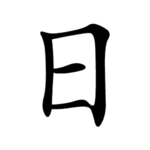Radical 72
Chinese character radical
| 日 | ||||
|---|---|---|---|---|
| ||||
| 日 (U+65E5) "sun, day" | ||||
| Pronunciations | ||||
| Pinyin: | rì | |||
| Bopomofo: | ㄖˋ | |||
| Gwoyeu Romatzyh: | ryh | |||
| Wade–Giles: | jih4 | |||
| Cantonese Yale: | yaht | |||
| Jyutping: | jat6 | |||
| Pe̍h-ōe-jī: | ji̍t | |||
| Japanese Kana: | ニチ nichi / ジツ jitsu (on'yomi) ひ hi (kun'yomi) | |||
| Sino-Korean: | 일 il | |||
| Names | ||||
| Chinese name(s): | (Left) 日字旁 rìzìpáng (Top) 日字頭/日字头 rìzìtóu | |||
| Japanese name(s): | 日/にち nichi (Left) 日偏/ひへん hihen (Left) 日偏/にちへん nichihen | |||
| Hangul: | 날 nal | |||
| Stroke order animation | ||||
 | ||||
Radical 72 or radical sun (日部) meaning "sun" or "day" is one of the 34 Kangxi radicals (214 radicals in total) composed of 4 strokes.
In the Kangxi Dictionary, there are 453 characters (out of 49,030) to be found under this radical.
日 is also the 75th indexing component in the Table of Indexing Chinese Character Components predominantly adopted by Simplified Chinese dictionaries published in mainland China, with 曰 (formerly Kangxi Radical 73 "say") and ⺜ being its associated indexing components.
Evolution
-
 Oracle bone script character
Oracle bone script character -
 Bronze script character
Bronze script character -
 Large seal script character
Large seal script character -
 Small seal script character
Small seal script character
Derived characters
| Strokes | Characters |
|---|---|
| +0 | 日 |
| +1 | 旦 旧SC/JP (=舊 -> 臼) |
| +2 | 早 旪 旫 旬 旭 旮 旯 |
| +3 | 旨 旰 旱 旲 旳 旴 旵 时SC (=時) 旷SC (=曠) 旸SC (=暘) |
| +4 | 旹 (=時) 旺 旻 旼 旽 旾 旿 昀 昁 昂 昃 昄 昅 昆 昇 昈 昉 昊 昋 昌 昍 明 昏 昐 昑 昒 易 昔 昕 昖 昗 昘 昙SC (=曇) 昛SC variant |
| +5 | 昚 昛TC variant 昜 昝 昞 星 映 昡 昢 昣 昤 春 昦 昧 昨 昩 昪 昫 昬 昭 昮 是 昰 (=是) 昱 昲 昳 昴 昵 昶 昷 昸 昹 昺 昻 昼SC/JP (=晝) 昽SC (=曨) 显SC (=顯 -> 頁) 昿JP nonstandard (=曠) |
| +6 | 晀 晁 時 晃 晄 晅 晆 晇 晈 晉 晊 晋 晌 晍 晎 晏 晐 晑 晒 晓SC (=曉) 晔 晕 晖SC (=暉) |
| +7 | 晗 晘 晙 晚 晛 晜 晝 晞 晟 晠 晡 晢 晣 晤 晥 晦 晧 晨 |
| +8 | 晩JP (=晚) 晪 晫 晬 晭 普 景 晰 晱 晲 晳 晴 晵 晶 晷 晸 晹 智 晻 晼 晽 晾 晿 暀 暁JP (=曉) 暂SC (=暫) 暃 暑 暎SC/JP variant (=映) |
| +9 | 暄 暅 暆 暇 暈 暉 暊 暋 暌 暍 暎TC variant (=映) 暏 暐 暒 暓 暔 暕 暖 暗 暘 暙 暛SC variant |
| +10 | 暚 暛TC variant 暜 暝 暞 暟 暠 暡 暢 暣 暤 暥 暦JP (=曆) 暧SC (=曖) 暨 暮SC/JP variant 暯SC variant 暱GB TC variant 曅GB TC variant |
| +11 | 暩 暪 暫 暬 暭 (=皞) 暮TC variant 暯TC variant 暰 暱Traditional variant 暲 暳 暴 暵 暶 暷 暹SC variant 曃SC variant 曂SC variant |
| +12 | 暸 暹TC/暹JP 暺 暻 暼 暽 暾 暿 曀 曁Kangxi (=暨) 曂TC variant 曃TC variant 曄 曅Traditional variant 曆 曇 曈 曉 曊 曋 曌 (=照 -> 火) 曍 (=皞) 曔SC variant |
| +13 | 曎 曏 曐 (=星) 曑 (=參 ->厶) 曒 曓 曔TC variant 曕 曖 曗 曚GB TC variant 曙SC/TC/JP variant |
| +14 | 曘 曙Kangxi/KO variant 曚Traditional variant 曛 曜 曞GB TC variant 曠GB TC variant |
| +15 | 曝 曞Traditional variant 曟 曠Traditional variant 曡 (=疊 -> 田) 曢 曤 曥 曦 曧 曨 |
| +16 | 曣 |
| +17 | 曩 |
| +19 | 曪 曫 曬 曮GB TC variant |
| +20 | 曭 曮Traditional variant |
| +21 | 曯 |
Sinogram
The radical is also used as an independent Chinese character. It is one of the kyōiku kanji or kanji taught in elementary school in Japan.[1] It is a first grade kanji.[1]
References
- ^ a b "The Kyoiku Kanji (教育漢字) - Kanshudo". www.kanshudo.com. Archived from the original on March 24, 2022. Retrieved 2023-05-06.
Literature
- Fazzioli, Edoardo (1987). Chinese calligraphy : from pictograph to ideogram : the history of 214 essential Chinese/Japanese characters. calligraphy by Rebecca Hon Ko. New York: Abbeville Press. ISBN 0-89659-774-1.
- Lunde, Ken (Jan 5, 2009). "Appendix J: Japanese Character Sets" (PDF). CJKV Information Processing: Chinese, Japanese, Korean & Vietnamese Computing (Second ed.). Sebastopol, Calif.: O'Reilly Media. ISBN 978-0-596-51447-1.
External links

Wikimedia Commons has media related to Radical 072.
- Unihan Database - U+65E5
- v
- t
- e
Chinese radicals according to the Kangxi Dictionary
- 211 齒
- 214 龠
See also: Kangxi radicals


















